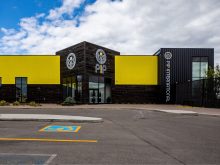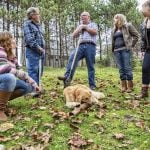Expanding communities one business at a time is how the Saskatchewan Small Business Loan Association program likes to think it works.
Since the provincial government set it up in 1989, the program has helped establish thousands of small businesses across the province.
Four men in Eastend were able to buy the former Saskatchewan Wheat Pool elevator and turn it into a facility that offered grain cleaning and feed mill services to local farmers.
Two brothers in St. Walburg bought a garage that had provided farm and automotive repairs and parts for more than 50 years.
Read Also

Volunteers help exotic animal farm rebuild
Exotic animal farm loses beloved camel and pony to huge hail storm that gripped the Brooks, Alta. area as a community member starts a fundraiser to help the family recover from the financial and emotional damage.
A woman has been able to set up a custom embroidery business on her farm near Coronach and a Melville farm family built an abattoir.
Birdie Thompson, one of four people who work for the program, said these are some of the 8,634 new and existing businesses that have been helped in the past 15 years.
She told a community economic development conference March 25 that the program sets up a group of four to six people who are willing to be mentors for entrepreneurs in their town.
The 239 local associations apply for money from the program’s $20 million fund, which is then lent to local businesses. The local groups can lend out as much as $10,000 to 10 businesses, for a maximum of $100,000 per community at any one time.
The local groups oversee the businesses to ensure they make their monthly payments. Interest from the loans, which would be $6,000 this year if the community was borrowing the maximum amount, is spent on local projects such as day-care equipment, park renovation or student scholarships.
Thompson said the program has created 19,051 jobs since inception and $119 million has been borrowed.
Staff member Larry Caderma said the program depends on local people because they “know the characters and whether the loan will be successful. Big banks look at the business plan and just care whether you’ll make a profit right away or not.”
Thompson said the default rate is about six percent, lower than the banks, which assume they will lose 10 percent of their loans.
While the program functions as a lender of last resort, Thompson said it wants to create clients for the banks by helping little businesses become larger.
“We haven’t got enough money in the provincial government to fund every business proposal, nor would we want to.”
Dean Froese of Herbert, Sask., outlined a similar program with which he volunteers – the federally funded Community Futures committees.
They were developed in 1986 and now include 266 across Canada, The CFs provide local entrepreneurs with advice and financing to help them revitalize rural areas.
“So many of our towns want to stop the bleeding (of people and jobs). They need to know how to find the Band-Aids.”
Youth focus
Froese said CFs focus on youth because they represent hope for the future and are more open to new ways of doing things. A recent project in Gull Lake, Sask., saw a group of young people paint the abandoned buildings in town to spruce up the main street.
The fund offers loans to a maximum of $125,000 and works with clients to do the hard job of whipping their business plans into shape.
“So often people come in and think they can get a loan in three hours,” Froese said.
“We have to discourage them.”
For larger businesses, venture capital funds are a private source of financing. Randy Beattie of Prairie Financial Management told the conference his firm has $80 million to invest. It looks at 140 potential deals a year and goes with a dozen.
He said his firm takes more risks than banks but expects a bigger return. It will take a seat on a firm’s board for five to seven years and analyze missed opportunities.
Koenders, a pond mill manufacturer in Englefeld, Sask., is one of Prairie Financial Management’s success stories. The owner wanted to retire and the venture capital company helped the employees buy the company.
Louis Hradecki, chair of the Canadian Adaptation and Rural Development fund’s Saskatchewan committee, said there is no shortage of ideas and money in rural areas.
“There’s a shortage in linking ideas and money,” he said.
















